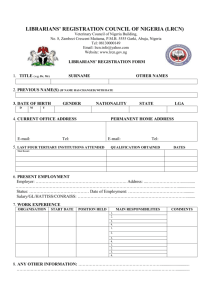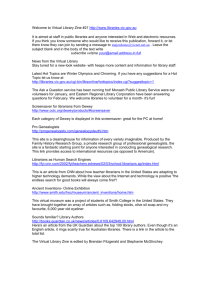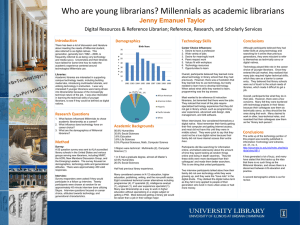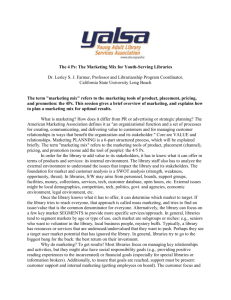Selection Criteria for Computer Software and Hardware: A Case
advertisement
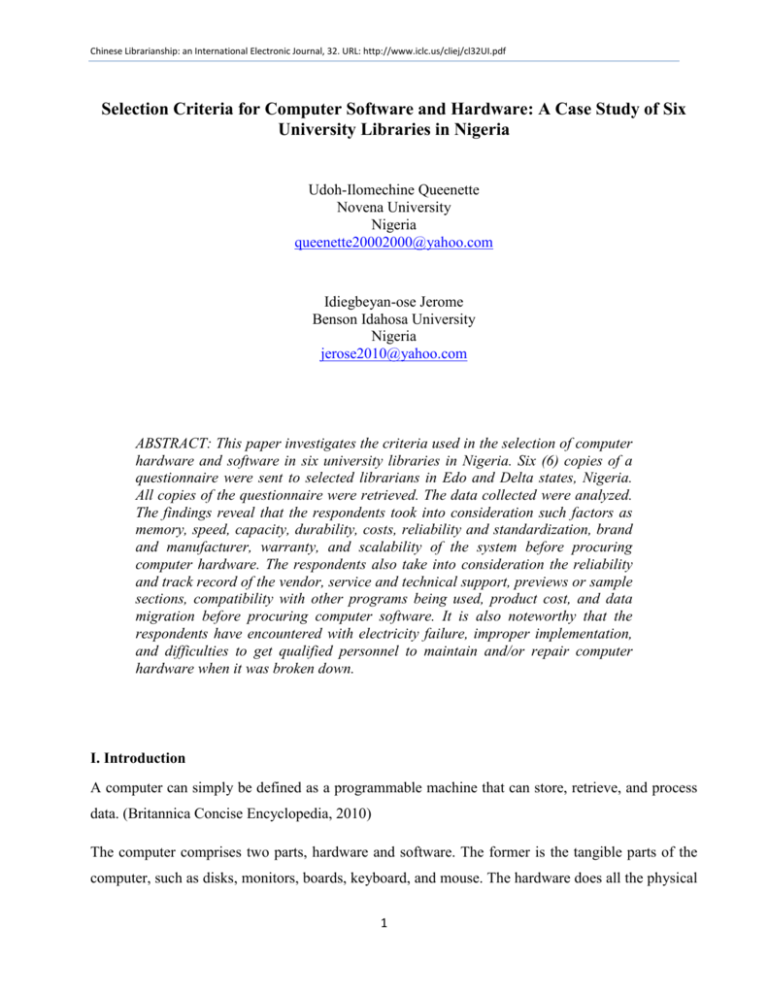
Chinese Librarianship: an International Electronic Journal, 32. URL: http://www.iclc.us/cliej/cl32UI.pdf Selection Criteria for Computer Software and Hardware: A Case Study of Six University Libraries in Nigeria Udoh-Ilomechine Queenette Novena University Nigeria queenette20002000@yahoo.com Idiegbeyan-ose Jerome Benson Idahosa University Nigeria jerose2010@yahoo.com ABSTRACT: This paper investigates the criteria used in the selection of computer hardware and software in six university libraries in Nigeria. Six (6) copies of a questionnaire were sent to selected librarians in Edo and Delta states, Nigeria. All copies of the questionnaire were retrieved. The data collected were analyzed. The findings reveal that the respondents took into consideration such factors as memory, speed, capacity, durability, costs, reliability and standardization, brand and manufacturer, warranty, and scalability of the system before procuring computer hardware. The respondents also take into consideration the reliability and track record of the vendor, service and technical support, previews or sample sections, compatibility with other programs being used, product cost, and data migration before procuring computer software. It is also noteworthy that the respondents have encountered with electricity failure, improper implementation, and difficulties to get qualified personnel to maintain and/or repair computer hardware when it was broken down. I. Introduction A computer can simply be defined as a programmable machine that can store, retrieve, and process data. (Britannica Concise Encyclopedia, 2010) The computer comprises two parts, hardware and software. The former is the tangible parts of the computer, such as disks, monitors, boards, keyboard, and mouse. The hardware does all the physical 1 Chinese Librarianship: an International Electronic Journal, 32. URL: http://www.iclc.us/cliej/cl32UI.pdf work of the computer, from memory storage to display. The software acts as the brain of the computer, telling the hardware what to do and how to do it. Computer software is intangible and can be grouped into two categories: a) system software and b) application software. (Askdeb.com, 2010) This study will focus on computer hardware and library application software that enable librarians to perform specialized tasks such as library automation. Examples of such specialized application software are; Alice for Windows, GLASS, CDS/ISIS, Strategic Library Automation and Management (SLAM), Liberty, Tin-Lib, and X-Lib. The selection and use of appropriate computer software and hardware to carryout library operation is a challenge. Lack of time and experience to make good decisions about particular products can make the selection a daunting task. Oketunji (2006) noted that today there are so many software packages in the market, designed for libraries, information and documentation centers. A comprehensive list of software packages for librarians have been compiled by Tyler and Grunson, (1998), including mastalib, Alice, GLASS, X-LIB, and CDS/ISIS. In Nigeria, most of the federal universities have one version of the tin-lib or another. In 1993, the national university commission (NUC) of Nigeria recommended the tin-lib to all the 36 federal university libraries. Many of these libraries have procured the package despite the fact that some did not have any computer system to install it (Oladapo, 2005). Library management system software used in Nigerian academic libraries includes CD/ISIS, X-lib, Glass, and Alice (Abdulraheen & Tiamiyu, 2005). Oduwole (2005) found that 16 federal universities have automated their cataloging processes using the TIN-LIB software. Libraries such as Nigeria Institute of Social and Economic Research (NISER) and the Institute of French Research in Africa (IFRA) library within the University of Ibadan use CDS/ISIS (Ezomo, 2003). Other library management software use by some international research libraries is Inmagic DB/TextWorks (Adedigba and Ezomo 2003). The library and documentation center for the International Institute of Tropical Agriculture (IITA) in Ibadan presently uses Inmagic DB/TextWorks for all library functions. The most important decision to be considered in a library automation is the selection of software to use. According to Ciberalli (1996), “the rule of the thumb for automation used to be to select the software first, and then hardware selection would be narrowed to the computers on which the software could operate. It must be noted 2 Chinese Librarianship: an International Electronic Journal, 32. URL: http://www.iclc.us/cliej/cl32UI.pdf that the greatest computer in the world is of little value if the software one needs to run the computer is not available”. II. Objective of Study The objective of the study is to find out: What are the factors taken into consideration before procuring computer hardware? What are the factors taken into consideration before procuring computer software? What are the problems encountered? III. Literature Review Technology Group International (2004) listed a set of hardware selection criteria: Compatibility and industry standards, Ease of operations, and Support cost. Oketunji (2006) suggested a set of necessary criteria for selecting software: Enable users to do something they couldn’t otherwise do, or to do things better or more efficiently; Is multipurpose, versatile, and open-ended; Appeals to a wide range of ages and interest;, Is easy to use; Offers constructive feedback (both positive and negative); Encourages creative, individualized, original input; Enhances content through electronics presentation; Provides audio help and/or instructions, or, where on-screen, help is clear and useful; Employs tasteful and attractive graphics that are non-violent, free of gender or ethic stereotypes; Representatives of user population; Provides a tangible product; Is fun to use and gives user a sense of accomplishment. He went further to say that librarians should avoid software that: Limits user interaction to pressing the return key or making a choice between presented options; Requires simultaneous depression of several keys in order to accomplish a routine or frequently used function; Has large amount of text on the screen; Does not allow the user to control sound levels, timing, or other intrusive features; Presents content in a violent, racist, or condescending fashion; Duplicates experience that-is just as easily or more easily presented in another medium or through a more versatile software product; Is little more than an automated workbook; Repeats exaggerated or lengthy graphics displays that have little to do with content. He added the following as guidelines for selecting software: Hardware connections, Your right in respect of the software, History of the supplier, Possibility of preview or demonstration, Pricing structure, Level of sophistication, Support issues, References sites, Parameterization, Teaching aids, System administration, and Needs for documentation. 3 Chinese Librarianship: an International Electronic Journal, 32. URL: http://www.iclc.us/cliej/cl32UI.pdf IV. Research Scope and Methodology The research population for this study comprised 6 librarians in academic libraries in Edo and Delta states, Nigeria. The instrument employed for the collection of data was a questionnaire. The data obtained from the retrieved copies of the questionnaires were analyzed using simple percentages. Table 1 shows the institutions and their respective categories to which the respondents are affiliated. Table 1: Respondents’ Affiliation and Institution Category SN 1 2 3 4 5 6 Institution Ambrose Ali university, Ekpoma Benson Idahosa University, Benin city Delta State University, Abraka Igbinedion University, Okada Novena University, Ogume University of Benin, Benin City Total Category State Private State Private Private Federal 6 V. Data Analysis and Interpretation Section A: Respondents’ personal data Table 2: Gender of Respondents Gender No. of Respondents Percentage (%) Male 2 34 Female 4 67 Total 6 100 The data in Table 2 reveals that there are more female librarians are 4(67%) than their male counterparts. This does not corroborate the findings of Adomi, Ayo and Nakpodia (2007) that there were more males than female librarians in the university libraries. 4 Chinese Librarianship: an International Electronic Journal, 32. URL: http://www.iclc.us/cliej/cl32UI.pdf Table 3: Working Experience Years No. of Respondents Percentage (%) 6-10 11-15 16-20 21 and above 6 100 Total 6 100 Table 3 shows that 6(100%) respondents have worked 21 or more years. This means that all of them would have had enough experience and exposure to computer software and hardware selection, which enable them to answer the questions in the questionnaire. Table 4: Qualification of Respondents Degrees No. of Respondents Percentage (%) BA/BS/BLS PgD 1 17 MA/MS 1 17 Ph.D. 4 66 Total 6 100 Note: PgD (Postgraduate Diploma) Table 4 indicates that 1(17%) of respondents holds PgD, 1(17%) holds MA/MS, while 4(66%) hold Ph.D. respectively. The data indicates that all respondents have received post-graduate education. Section B: Respondents’ responses to questions: 1. What are the factors taken into consideration before procuring computer hardware? Table 5: Factors in considerations for procuring computer hardware Factors Brand/manufacturer Memory Speed Capacity Durability Cost Warranty Technical support Users manual/guide Scalability of the system Reliability of the system Agree 3 5 5 5 5 5 4 3 3 3 5 5 % Disagree % Uncertain % 50 1 17 2 33 83 1 17 83 1 17 83 1 17 83 1 17 83 1 17 67 2 33 50 2 33 1 17 50 3 50 50 1 17 2 40 83 1 17 Chinese Librarianship: an International Electronic Journal, 32. URL: http://www.iclc.us/cliej/cl32UI.pdf Standardization of the system 5 83 - - 1 17 Table 5 shows that 5(83%) of respondents took into consideration memory, speed, capacity, durability, cost, reliability of the system and standardization of the systems, while 3(60%) took brand/manufacturer, warranty and scalability of the system into consideration. This finding agrees with Tiamiyu (2005) who stated that speed, scalability of the system, reliability of the system, standardization, and PC technical support should be taken into consideration before procuring computer hardware. 2. What are the factors taken into consideration before procuring computer software? Table 6: Factors in consideration for procuring computer software Factors Reliability and track record of the vendor Service and technical support Compatibility of software with current and future hardware History/ availability of updates/revision Preview/ sample sections Compatibility with other program being used Ease of operation and installation Product cost Data migration A 5 5 4 3 5 5 3 5 5 % 83 83 66 50 83 83 50 83 83 D 1 3 3 - % 17 50 50 - U 1 1 1 1 1 1 1 % 17 17 17 17 17 17 17 Table 6 shows that 5(83%) of respondents take into consideration reliability and track record of the vendor, service and technical support, previews/sample sections, compatibility with other program being used, product cost and data migration before procuring computer software. However, 3(50%) considered compatibility of software with current and future hardware and ease of operation, ease of operation and installation before procuring computer systems software. This finding corroborates with Oketunji (2006), who listed factors to consider, such as hardware connections, rights in respect of the software, history of the supplier, possibility of preview or demonstration, pricing structure, level of sophistication, support issues, reference sites, parameterization, teaching aids, system administration, and needs for documentation. 6 Chinese Librarianship: an International Electronic Journal, 32. URL: http://www.iclc.us/cliej/cl32UI.pdf 3. What are the problems encountered? Table 7: Librarians encounters the following problems Problems Improper implementation and test running Epileptic power supply Compatibility with existing hardware Finance Difficulty getting qualified personnel to maintain/ repair computer hardware when it breakdown A 5 5 3 3 5 % 83 83 50 50 83 D 1 1 3 3 1 % 17 17 50 50 17 U - % - Table 7 shows that 5(83%) of respondents encountered electricity failure, improper implementation and test running, and difficulty getting qualified personal to maintain/repair computer hardware when it was broken down. The finding of this study supports Adomi and Anie (2006), who stated that electric power supply and connectivity is one of the problems librarians encounter in the use of computer. VI. Conclusion Based on the findings of this study, it can be concluded that during the selection of computer hardware, librarians will take into consideration such factors as the memory, speed, capacity, durability, cost, reliability, standardization, brand/manufacturer, warranty, scalability, and user’s manual/guide. To select computer software, librarians will look into such factors as the reliability and track record of the vendor, service and technical support, preview/sample sections, compatibility with other programs being used, product cost, data migration, ease of operations and installation References Adedigba, Y. A., & Ezomo, E. O. (2003). The management of system migration in an African setting. African Journal of Library, Archival and Information Science, 13(1), 33-42. Adomi, E. E., & Anie, S. O. (2006). An assessment of computer literacy skills of professionals in Nigerian university libraries. Library Hi Tech News, 23(2), 10-14. 7 Chinese Librarianship: an International Electronic Journal, 32. URL: http://www.iclc.us/cliej/cl32UI.pdf Adomi, E. E.; Ayo, B. T.; & Napodia, E. D. (2007). A better response rate for questionnaires: Attitudes of librarians in Nigerian university libraries. Library philosophy and practice. Retrieved May 14, 2011 from: http://unllib.unl.edu/LPP/adomi-ayo-nakpodia.htm Arua, U. (2005). Computerization of library operations: Some necessary considerations. In Lasisi J., et al. (Eds.) Computerization of library operations in the information age. Lagos: NLA, Cataloguing, Classification and Indexing Section: 110 -113. Cibbarilli, P. (2000). Library automation alternative in the 1990s and user satisfaction rating of the user by operating system: Computers in Library, 16(2), 26-35. Ezomo, E. O. (2003). Automated acquisition principles and practice. Journal of Library and Information science, 1(2), 120-124. Fatoki, I. C. (2002). Trends and standards in software selection in Nigerian libraries. Gate Way Library Journals, 5(1/2), 1-13. Komoski, P. K., & Plotnick, E. (1995). Seven steps to responsible software selection. ERIC Digests, ED382157. Oketunji, I. (2006). Current trends in information and communication technology: Application to technical services. Proceedings of Selected Papers of the Cataloguing, Classification and Indexing Section of the Nigerian Library Association, 2003-2004. Oladapo, S. T. A. (2005). The challenges of information and communication technologies (ICT) to cataloguing and classification and bibliographic services. A paper presented at the National Workshop on Strategies for Managing Technological Services in Libraries and Information Centre organized by the Cataloguing Classification and Indexing Section of Nigerian Library Association held at the Osun State NUJ Press Centre, Osogbo, Osun State, 24-27th October 2005. Omekwu, C. (2001). Managing information and technology in the knowledge age: Pacesetting agenda for libraries and librarians in developing economics. A Compendium of Papers Presented at the 2001 NLA Annual National Conference and AGM, Owerri, 17-22 June, pp. 40-50. Tyler, I. K. D. (1998). The problems in computer literacy training: Are we preparing students for a computer intensive future? Retrieved July 7, 2007 from: http://www.ccs.neu.edu/home/romulus/papers/mywr/report.htm 8 Chinese Librarianship: an International Electronic Journal, 32. URL: http://www.iclc.us/cliej/cl32UI.pdf Author: Udoh-Ilomechine Queenette, Novena University, Ogume, Delta State, Nigeria. Email: queenette20002000@yahoo.com Idiegbeyan-ose Jerome, Benson Idahosa University, Benin City, Edo State, Nigeria. Email: jerose2010@yahoo.com Submitted to CLIEJ on 17 August 2011 Copyright © 2011 Udoh-Ilomechine Queenette & Idiegbeyan-ose Jerome Udoh-Ilomechine, Queenette; & Idiegbeyan-ose, Jerome. (2011). Selection criteria for computer software and hardware: A case study of six university libraries in Nigeria. Chinese Librarianship: an International Electronic Journal, 32. URL: http://www.iclc.us/cliej/cl32UI.pdf 9

